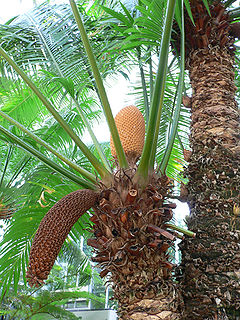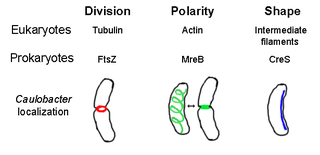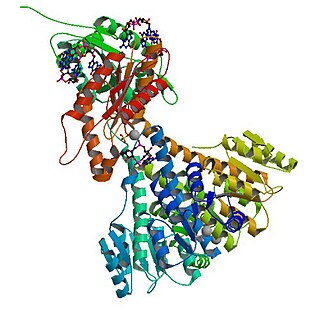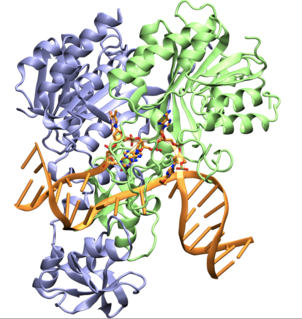Related Research Articles

Pseudomonadota is a major phylum of Gram-negative bacteria. The renaming of phyla in 2021 remains controversial among microbiologists, many of whom continue to use the earlier names of long standing in the literature. The phylum Proteobacteria includes a wide variety of pathogenic genera, such as Escherichia, Salmonella, Vibrio, Yersinia, Legionella, and many others. Others are free-living (nonparasitic) and include many of the bacteria responsible for nitrogen fixation.

The Noctilucales are an order of marine dinoflagellates. They differ from most others in that the mature cell is diploid and its nucleus does not show a dinokaryotic organization. They show gametic meiosis.

Cycads are seed plants that typically have a stout and woody (ligneous) trunk with a crown of large, hard, stiff, evergreen and (usually) pinnate leaves. The species are dioecious, that is, individual plants of a species are either male or female. Cycads vary in size from having trunks only a few centimeters to several meters tall. They typically grow very slowly and live very long, with some specimens known to be as much as 1,000 years old. Because of their superficial resemblance, they are sometimes mistaken for palms or ferns, but they are not closely related to either group.
The Thermomicrobia is a group of thermophilic green non-sulfur bacteria. Based on species Thermomicrobium roseum and Sphaerobacter thermophilus, this bacteria class has the following description:

Caulobacter crescentus is a Gram-negative, oligotrophic bacterium widely distributed in fresh water lakes and streams. The taxon is more properly known as Caulobacter vibrioides.

Caulobacteraceae is a family of proteobacteria within the alpha subgroup. Like all Proteobacteria, the Caulobacteraceae are gram-negative. Caulobacteraceae includes the genera Asticcacaulis, Brevundimonas, Phenylobacterium and Caulobacter.

Caulobacter is a genus of Gram-negative bacteria in the class Alphaproteobacteria. Its best-known member is Caulobacter crescentus, an organism ubiquitous in freshwater lakes and rivers; many members of the genus are specialized to oligotrophic environments.
Prosthecate bacteria are a non-phylogenetically related group of Gram-negative bacteria that possess appendages, termed prosthecae. These cellular appendages are neither pili nor flagella, as they are extensions of the cellular membrane and contain cytosol. One notable group of prosthecates is the genus Caulobacter.
Maricaulis is a genus of the Maricaulaceae.

The prokaryotic cytoskeleton is the collective name for all structural filaments in prokaryotes. It was once thought that prokaryotic cells did not possess cytoskeletons, but advances in visualization technology and structure determination led to the discovery of filaments in these cells in the early 1990s. Not only have analogues for all major cytoskeletal proteins in eukaryotes been found in prokaryotes, cytoskeletal proteins with no known eukaryotic homologues have also been discovered. Cytoskeletal elements play essential roles in cell division, protection, shape determination, and polarity determination in various prokaryotes.

Cyclic di-GMP is a second messenger used in signal transduction in a wide variety of bacteria. Cyclic di-GMP is not known to be used by archaea, and has only been observed in eukaryotes in Dictyostelium. The biological role of cyclic di-GMP was first uncovered when it was identified as an allosteric activator of a cellulose synthase found in Gluconacetobacter xylinus in order to produce microbial cellulose.

In enzymology, diguanylate cyclase, also known as diguanylate kinase, is an enzyme that catalyzes the chemical reaction:
The Asticcacaulis are a genus of proteobacteria.
Zavarzinella is an aerobic genus of bacteria from the family of Planctomycetaceae with one known species. Zavarzinella formosa has been isolated from Sphagnum peat from West Siberia.
Planctomicrobium is an aerobic genus of bacteria from the family of Planctomycetaceae with one known species. Planctomicrobium piriforme has been isolated from littoral wetland from the Valaam Island in Russia.
Asticcacaulis benevestitus is a Gram-negative, aerobic, heterotrophic and psychrotolerant bacterium from the genus of Asticcacaulis which has been isolated from shrub tundra wetland from the Polar Urals in Russia.
Asticcacaulis endophyticus is a Gram-negative, strictly aerobic, rod-shaped and motile bacterium from the genus of Asticcacaulis which has been isolated from the roots of the plant Geum aleppicum from the Taibai Mountain in China.
Asticcacaulis solisilvae is a Gram-negative, obligately aerobic, chemoheterotrophic and motile bacterium from the genus of Asticcacaulis which has been isolated from forest soil from the Cheonggyesan Mountain in Korea.
Asticcacaulis taihuensis is a bacterium from the genus of Asticcacaulis which has been isolated from sediments of the Taihu Lake in China.

CcrM is an orphan DNA methyltransferase, that is involved in controlling gene expression in most Alphaproteobacteria. This enzyme modifies DNA by catalyzing the transference of a methyl group from the S-adenosyl-L methionine substrate to the N6 position of an adenine base in the sequence 5'-GANTC-3' with high specificity. In some lineages such as SAR11, the homologous enzymes possess 5'-GAWTC-3' specificity. In Caulobacter crescentus Ccrm is produced at the end of the replication cycle when Ccrm recognition sites are hemimethylated, rapidly methylating the DNA. CcrM is essential in other Alphaproteobacteria but is role is not yet determined. CcrM is a highly specific methyltransferase with a novel DNA recognition mechanism.
References
- ↑ Poindexter, JS (Sep 1964). "BIOLOGICAL PROPERTIES AND CLASSIFICATION OF THE CAULOBACTER GROUP". Microbiol. Mol. Biol. Rev. 28 (3): 231–95. doi:10.1128/mmbr.28.3.231-295.1964. PMC 441226 . PMID 14220656.
- ↑ Pate, JL; Porter JS; Jordan TL. (Nov 1973). "Asticcacaulis biprosthecum sp.nov. Life cycle, morphology and cultural characteristics". Antonie van Leeuwenhoek. 39 (4): 569–83. doi:10.1007/bf02578901. PMID 4588538.